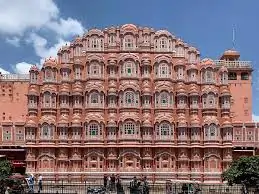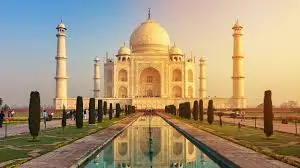The Hawa Mahal, or “Palace of Winds,” in Jaipur, Rajasthan, is a stunning architectural marvel with 953 intricately carved windows, built in 1799 to allow royal women to view street festivities while remaining unseen.
ADVERTIDEMENT

Table of Contents

Hawa Mahal (Jaipur, Rajasthan)
The Hawa Mahal, also referred to as the “Palace of Winds,” is an architectural marvel that stands as a testament to the grandeur of Jaipur’s royal past. Built in 1799 by Maharaja Sawai Pratap Singh, this five-story palace is not only a stunning example of architectural ingenuity but also a symbol of Rajasthan’s rich cultural heritage. Located in the heart of Jaipur, the Hawa Mahal has become an iconic landmark that attracts visitors from around the world, eager to witness its historical and artistic significance.
Constructed from red and pink sandstone, the Hawa Mahal blends seamlessly into Jaipur’s “Pink City” aesthetic. Its distinctive honeycomb façade, featuring 953 intricately carved windows, or jharokhas, is a masterpiece of design and functionality. These small windows, adorned with exquisite latticework, give the palace its signature look, resembling a delicate screen that appears almost ethereal when sunlight filters through it. The façade, shaped like a crown, is believed to reflect the devotion of Maharaja Pratap Singh to Lord Krishna, as it resembles the deity’s crown.
The palace is a harmonious fusion of Rajput and Mughal architectural styles, showcasing the Rajput emphasis on vibrant aesthetics and the Mughal tradition of intricate ornamentation. While the exterior is highly decorative, the interior is surprisingly simple, designed for practicality and comfort.
The Hawa Mahal was primarily built to serve the women of the royal household, who were bound by the purdah system, which required them to remain veiled and secluded from public view. The palace’s lattice-covered windows allowed these women to observe street festivals, processions, and daily life without being seen themselves, ensuring their privacy while still keeping them connected to the vibrant life of the city.
In addition to its cultural purpose, the palace’s design also demonstrates remarkable engineering. The latticework on the windows not only served as a screen but also facilitated cross-ventilation, creating a natural cooling effect. This innovative feature ensured that the interiors remained breezy and comfortable even during Jaipur’s hot summers, earning the palace its name, “Palace of Winds.”
I. Introduction
The Hawa Mahal, or “Palace of Winds,” is one of the most iconic landmarks in Jaipur, Rajasthan, and a symbol of India’s rich architectural heritage. Built in 1799 by Maharaja Sawai Pratap Singh, it is a testament to the ingenuity and artistry of the Rajputana era.
This five-story palace is renowned for its unique façade, adorned with 953 intricately carved windows, designed to allow air circulation and create a cooling effect, hence the name “Palace of Winds.” Located in the heart of Jaipur’s bustling streets, it reflects the city’s vibrant culture and history. Its strategic location and stunning architecture make it a cornerstone of Jaipur’s identity, blending Rajput and Mughal architectural styles.
II. Historical Background
Purpose of Construction
The Hawa Mahal was constructed primarily to serve the women of the royal household, who followed the strict purdah system, a practice of seclusion that prevented them from appearing in public. The palace was designed to enable them to observe street life, processions, and festivals without compromising their privacy.
Additionally, Maharaja Sawai Pratap Singh was a devout follower of Lord Krishna, and the structure’s façade was inspired by the crown of the deity, symbolizing devotion and spiritual reverence.
Architect
The Hawa Mahal was designed by Lal Chand Ustad, a master architect who combined elements of Rajput and Mughal architecture. The design was influenced by Khetri Mahal, a similar structure in Jhunjhunu, known for its jharokha-style architecture.
Influence
The palace reflects the socio-cultural norms of the time while showcasing the Rajput tradition of blending functionality with artistic expression. It stands as a tribute to the architectural vision of the era and the cultural ethos of Rajasthan.
III. Architectural Features
Design and Materials
The Hawa Mahal is constructed from red and pink sandstone, blending seamlessly with Jaipur’s “Pink City” aesthetic. Its five-story structure is pyramid-shaped, tapering as it rises, giving it a distinct and delicate appearance. Despite its grandeur, the palace was not designed as a residence but as an extension of the City Palace, directly connected to the women’s quarters.
Honeycomb Façade
The façade of the Hawa Mahal is its most striking feature, with 953 small windows, or jharokhas, arranged in a honeycomb pattern. These windows are adorned with fine latticework, serving both an aesthetic and functional purpose. The intricate designs ensure that the interiors remain private and cool, while the windows provide natural ventilation, creating a comfortable environment even during Jaipur’s scorching summers.
Interior
In contrast to its ornate exterior, the interior of the Hawa Mahal is relatively simple. Narrow ramps connect the five stories, ensuring accessibility for the royal women. The chambers are small and shaded, designed to maintain privacy while offering comfort. The upper floors feature open terraces that provide panoramic views of Jaipur, including landmarks like the City Palace, Jantar Mantar, and Johari Bazaar.
Symbolism
The palace’s façade resembles the crown of Lord Krishna, symbolizing the Maharaja’s devotion. Its design reflects a harmonious blend of Rajput pride and Mughal elegance, emphasizing cultural and architectural innovation.
IV. Functional and Cultural Significance
Privacy for Royal Women
The Hawa Mahal was designed to address the needs of royal women who were not allowed to appear in public due to the purdah system. The latticework windows allowed them to observe processions, street festivals, and everyday life without being seen by outsiders. This unique design reflects the socio-cultural norms of the Rajput era.
Cooling System
The architectural design of the Hawa Mahal incorporated natural cooling mechanisms. The numerous windows and lattice patterns facilitated cross-ventilation, ensuring a constant flow of air even during the hottest months. This innovative design is a testament to the advanced engineering and climatic adaptability of Rajput architecture.
Part of Royal Complex
The Hawa Mahal was constructed as an extension of the City Palace, seamlessly connecting to the zenana (women’s quarters). This strategic placement allowed royal women to move discreetly between the two structures, enhancing their privacy and convenience.
V. Tourism and Modern Importance
Key Tourist Attraction
Today, the Hawa Mahal is one of Jaipur’s most popular tourist destinations, attracting visitors from across the globe. Its unique architecture, historical significance, and cultural relevance make it a must-visit landmark. Tourists are particularly drawn to its photogenic façade and the panoramic views from its upper floors.
Nearby Attractions
The Hawa Mahal’s location in the heart of Jaipur makes it an ideal starting point for exploring the city. Nearby attractions include Johari Bazaar, known for its jewelry, and Bapu Bazaar, famous for textiles and handicrafts. The City Palace and Jantar Mantar, both UNESCO World Heritage Sites, are within walking distance.
Cultural Events
The palace occasionally hosts exhibitions and cultural programs, offering visitors an opportunity to engage with Rajasthan’s vibrant traditions and art forms.
Maintenance and Preservation
Managed by the Archaeological Department of Rajasthan, the Hawa Mahal has been well-preserved to ensure its continued appeal and accessibility. Conservation efforts focus on restoring its intricate latticework and maintaining its structural integrity.
VI. Challenges and Conservation
Preservation Issues
The Hawa Mahal faces several challenges, including weathering, pollution, and the impact of high tourist footfall. The sandstone structure is particularly vulnerable to erosion from air pollution and monsoon rains. Overcrowding during peak tourist seasons also puts stress on the delicate interiors.
Conservation Efforts
The Archaeological Department of Rajasthan undertakes regular restoration and maintenance to preserve the palace’s intricate designs and architectural integrity. Efforts include cleaning the façade, repairing damaged jharokhas, and promoting sustainable tourism practices. Awareness campaigns encourage visitors to respect the monument and its historical significance.
VII. Conclusion
The Hawa Mahal is more than just an architectural masterpiece—it is a living embodiment of Jaipur’s history, culture, and artistic excellence. Its intricate façade, innovative design, and historical significance make it a testament to the ingenuity of Rajput and Mughal architecture.
As a symbol of privacy, functionality, and beauty, the Hawa Mahal continues to captivate visitors and inspire pride in India’s heritage. A visit to this iconic landmark offers not just a glimpse into the royal past but also a deeper appreciation for the cultural and architectural legacy of Rajasthan.

